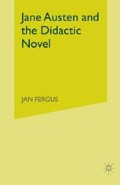Abstract
The best of Austen’s immediate predecessors and contemporaries in the novel create domestic and moralizing fiction which is highly patterned and explicitly didactic, although with substantial elements of more subtle literary art. Austen’s triumph in her early novels is to assimilate their achievements and to better them so that her own fiction realizes their aims: to delight and instruct. Her ability to delight is undeniable; her didactic intentions less acknowledged. In the early novels, Austen discovers themes and techniques which engage and increasingly complicate the reader’s judgments and sympathies. His emotions, perceptions and moral sense are exercised in an increasingly complete and realized world; his responses are jolted, tested and refined. Whether or not Q. D. Leavis is right to define the ‘peculiar property of a good novel’ as ‘the series of shocks it gives to the reader’s preconceptions’, she is wrong to claim that George Eliot ‘seems to have been the first novelist to be conscious of this most important function of the novel’.1 Not only Austen but Sterne and Richardson anticipate Eliot in being fully aware of this possible effect of the novel and fully determined to exploit it. A more significant comparison between Austen and Eliot links them also to Henry James. They share a conviction that literary experience can and should result in an enlarged or enriched consciousness. However differently all three might define an ‘enriched consciousness’ and however diverse their means of achieving it, they all make problems of intellectual, moral and emotional responsiveness central issues in their novels.
Access this chapter
Tax calculation will be finalised at checkout
Purchases are for personal use only
Preview
Unable to display preview. Download preview PDF.
Notes and References
Q. D. Leavis, Fiction and the Reading Public (London, 1932) p. 256.
Quoted by J. E. Austen-Leigh, Memoir, p. 157.
Unsigned review of Emma, Quarterly Review 14 (1816); rpt in Critical Heritage, p. 68.
D. F. Tovey, Essays in Musical Analysis, I (1935; rpt London, 1968) pp. 61 and 62.
B. C. Southam, Literary Manuscripts, p. 121.
Copyright information
© 1983 Jan Fergus
About this chapter
Cite this chapter
Fergus, J. (1983). Conclusion The Later Novels. In: Jane Austen and the Didactic Novel. Palgrave Macmillan, London. https://doi.org/10.1007/978-1-349-06100-6_6
Download citation
DOI: https://doi.org/10.1007/978-1-349-06100-6_6
Publisher Name: Palgrave Macmillan, London
Print ISBN: 978-1-349-06102-0
Online ISBN: 978-1-349-06100-6
eBook Packages: Palgrave Literature & Performing Arts CollectionLiterature, Cultural and Media Studies (R0)

